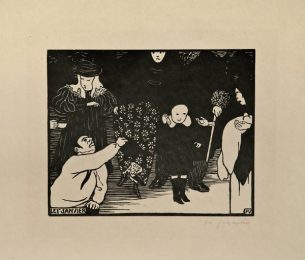Details — Click to read
Chiaroscuro woodcut from three blocks, printed in black, yellow-ochre and olive-green
Bartsch 231; Hirschmann, 373, III-3; Hollstein 373; Strauss 403 II/IV; Bialler 25 I c (of f, of VI); Leesberg (New Hollstein) 304 I e.; TIB 0301.231.
A fine impression, in the first state ‘c’ of six, Bialler 25 I c ( of f- of VI), printed on paper with ‘grapes in a shield ’ watermark (paper mill ‘J. Gouault’), similar to Briquet, n. 13215, datable on 1579-1586, before the wormhole on the right thumb of Cacus. In very good condition, the colours brilliantly fresh and well registered, with complete borderline and small margins on top and on the right edge.
In very good unwashed condition, apart from the horizontal drying fold, with gaufrage on the verso.
Draftsman, printmaker and painter,Hendrick Goltzius is one of the principal figure in Northern Mannerism and has a special place in the history of the chiaroscuro woodcut. His work depicts mythological subjects as well as portraits and landscapes in the Venetian tradition. ‘Hercules and Cacus’ is his largest, erliest and only dated woodcut. Nancy Bialler has been able to trace six states in no less than eight different colour combinations, all of which she presentedin the chiaroscuro print exhibition in Amsterdam and Cleveland (1992-93). The earliest impressions show more subtle and balanced colour schemes. Our print is one of these very early impressions and, according to Bialler’s description, there exist only two earlier statesof each impression (‘I a’ in Paris and ‘I b’ in Berlin). Together with three impressions of state ‘I c’, to which this one must be added, she called them ‘the earliest impressions’, differing only in the colour tone.
Hercules and Cacus was erroneously associated to an episode from the ‘Twelve Labors of Hercules’. In fact, although there is a connection with the ‘Twelve Labors’, the story was told by Ovid (Fasti I, 545-578) . Hercules capturing the cattle of Geryon. Cacus, the son of Vulcan, stole eight of Hercules’s cattle and hid them in his cave, then he blocked the entrance by chaining a boulder across the mouth. Hercules pursued him, broke in to the cave through the roof, and defeated him.
Goltzius shows Hercules at his moment of triumph.
























































